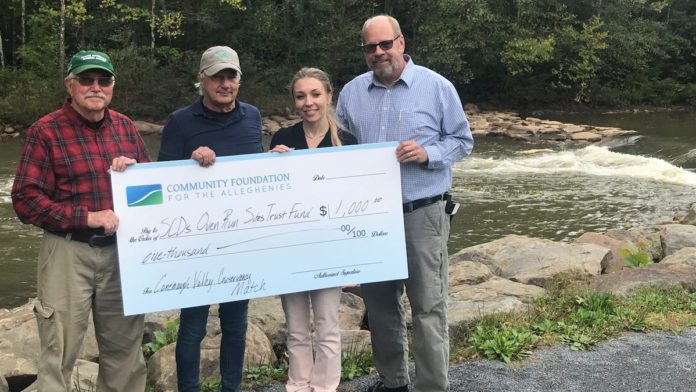Donors have met a $1,000 challenge from the Conemaugh Valley Conservancy to grow the Oven Run Sites A, D, E and F Trust Fund, a financial resource that aims to preserve the Stonycreek River as a living, healthy waterway for the region.
Tim Messer, conservancy president, and Rick Bloom, a conservancy board member, presented a $1,000 check on Wednesday to Len Lichvar, manager of the Somerset Conservation District and Kecia Bal from the Community Foundation for the Alleghenies, which manages the trust fund.
The presentation was held at Greenhouse Park, near Tire Hill. The manmade whitewater park is located on a section of the Stonycreek River that has benefitted over the last 25 years from the improved water quality produced by the Oven Run abandoned mine drainage, aka AMD, passive treatment sites in Shade Township.
A brief history: Oven Run’s colorful history has turned green
Where it started: SCRIP celebrates 30 years
What is the Oven Run trust fund?
The Oven Run Sites A, D, E and F Trust Fund started late last year with a $25,000 contribution from the Somerset County Commissioners. Under the management of the Community Foundation – and with donations from the community at large – the trust fund is meant to provide a source of financing for the future costs of maintenance and reconstruction of these four AMD treatment sites.
In April, the Conemaugh Valley Conservancy announced it would give $1,000 when the fund received its first $1,000 in donations.
“We brought it up to the board, and everybody on the board unanimously agreed,” Messer said. “We have $1,000, it’s not coming from a grant or a matched fund or anything, it’s coming from our endowment. But we believe that strongly that this money needs to go to protect our environment.”
The challenge was met by the end of April, Bal said.
Lichvar said the Somerset Conservation District is legally required to forever maintain these four AMD treatment sites, most of which are nearing their 20-to-25-year expected life cycle. The Conservation District is now in the process of updating these four sites, so the trust fund will provide funding for continued maintenance costs and future rebuilding needs.
“Forever’s a long time,” he said. “We’re the ones who have also maintained them for the last 20 years and will have to maintain them for an infinite amount of years in the future. So this trust fund is to help defer the cost of doing that on into the future.
“We never had a trust fund (before), but we will have for someone who has my job years from now when they go to physically construct them and maintain them again. This will be a viable funding option (for them). It’s been a huge challenge (to secure funding) and we’ll try to make it less challenging.”
Messer and Bloom said these AMD treatment sites are the reason why birds, waterfowl and fish are now common sights along parts of the Stonycreek River, which starts near Berlin and flows north into the City of Johnstown.
“I’ve been boating this river since the early 1990s, and when I started, you did not want to swim in that river because it was orange,” Bloom said. “Now I’m astounded to watch eagles, herons and (people) fly fishing. It’s a live river because of the (AMD) treatment.”
Messer added: “(At) Sandyvale, at least last year there was a pair of nesting bald eagles that were seen flying through the area. Herons (and other waterfowl), they don’t thrive in bad water. With all the sampling, all the invertebrate studies and fish counts, it shows that this is a live river.”
Help the Stonycreek survive
But the Stonycreek River cannot sustain this quality of life without continued efforts – and funding – to maintain the Oven Run AMD treatment sites, Lichvar said.
“We never eliminated one gallon of abandoned mine drainage, we’re only treating it – and if that treatment somehow fails, dissipates or goes away for whatever reason, the mine drainage will revert right back because there’s nothing to buffer.
“These aren’t AMD treatment systems, they are water quality factories. They take a raw material called polluted water and they turn it into clean water. Like any other factory or manufacturing industry, they take a raw material and they turn it into a usable product. That’s what these systems do . . . (and) they need to be viewed that way in order to sustain the funding.”
The new goal: Contributions sought for Oven Run Trust Fund
Recently, the Somerset County Conservancy announced its own challenge, making a commitment to give a $5,000 matching donation when the trust fund secures its next $5,000 in donations. To contribute, visit the Somerset Conservation District Oven Run Treatment Sites A, D, E and F Trust Fund page at the Community Foundation’s website.
“We’re hoping the Somerset Conservancy saw us and said, ‘We’re going to one-up them with (their) challenge’ and that’s a good thing,” Messer said. “Hop on board – there’s plenty of room for everybody here.”
Credit: Source link































